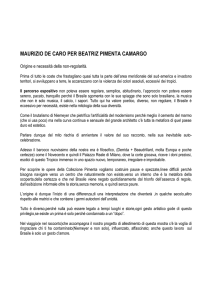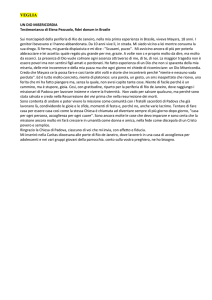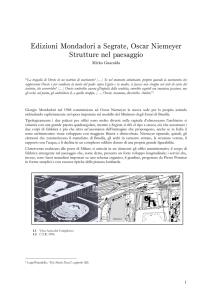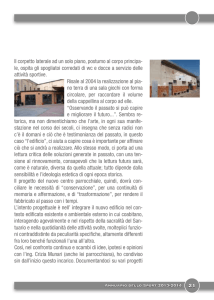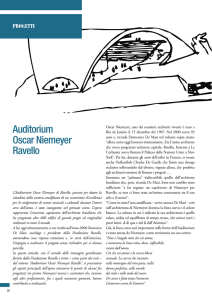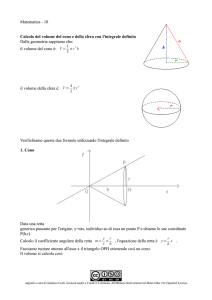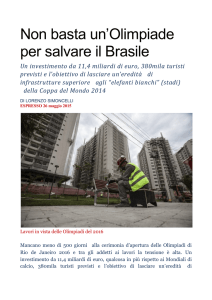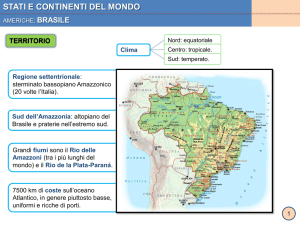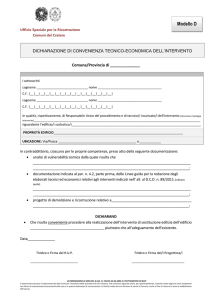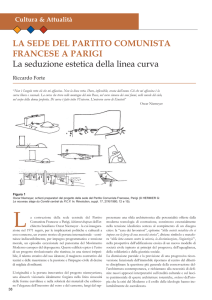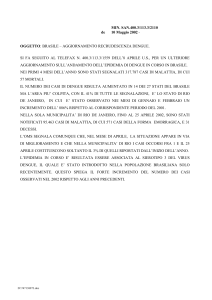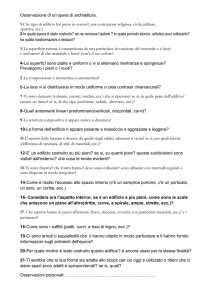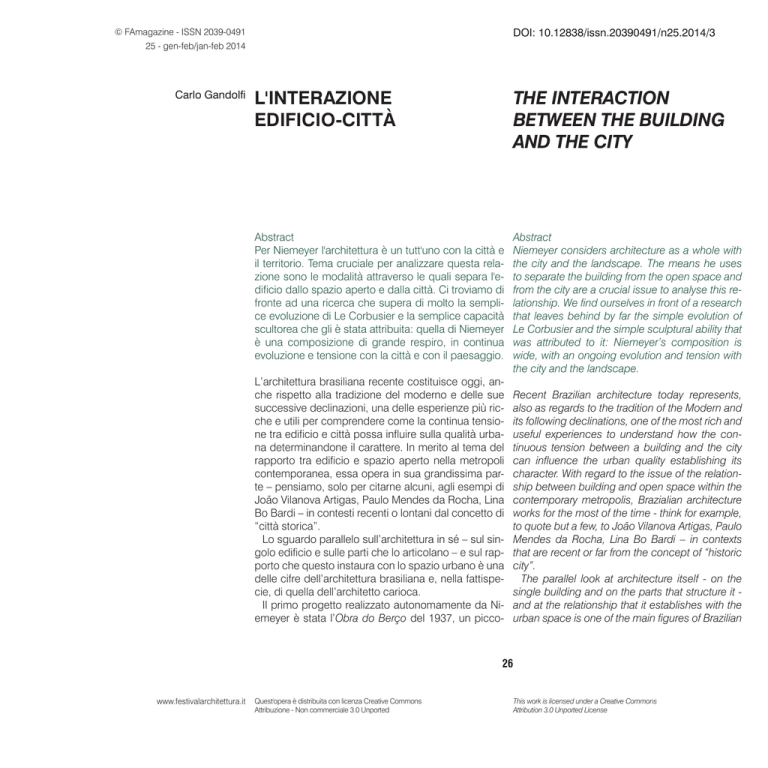
DOI: 10.12838/issn.20390491/n25.2014/3
© FAmagazine - ISSN 2039-0491
25 - gen-feb/jan-feb 2014
Carlo Gandolfi
L'INTERAZIONE
EDIFICIO-CITTÀ
THE INTERACTION
BETWEEN THE BUILDING
AND THE CITY
Abstract
Per Niemeyer l'architettura è un tutt'uno con la città e
il territorio. Tema cruciale per analizzare questa relazione sono le modalità attraverso le quali separa l'edificio dallo spazio aperto e dalla città. Ci troviamo di
fronte ad una ricerca che supera di molto la semplice evoluzione di Le Corbusier e la semplice capacità
scultorea che gli è stata attribuita: quella di Niemeyer
è una composizione di grande respiro, in continua
evoluzione e tensione con la città e con il paesaggio.
Abstract
Niemeyer considers architecture as a whole with
the city and the landscape. The means he uses
to separate the building from the open space and
from the city are a crucial issue to analyse this relationship. We find ourselves in front of a research
that leaves behind by far the simple evolution of
Le Corbusier and the simple sculptural ability that
was attributed to it: Niemeyer’s composition is
wide, with an ongoing evolution and tension with
the city and the landscape.
L’architettura brasiliana recente costituisce oggi, anche rispetto alla tradizione del moderno e delle sue
successive declinazioni, una delle esperienze più ricche e utili per comprendere come la continua tensione tra edificio e città possa influire sulla qualità urbana determinandone il carattere. In merito al tema del
rapporto tra edificio e spazio aperto nella metropoli
contemporanea, essa opera in sua grandissima parte – pensiamo, solo per citarne alcuni, agli esempi di
João Vilanova Artigas, Paulo Mendes da Rocha, Lina
Bo Bardi – in contesti recenti o lontani dal concetto di
“città storica”.
Lo sguardo parallelo sull’architettura in sé – sul singolo edificio e sulle parti che lo articolano – e sul rapporto che questo instaura con lo spazio urbano è una
delle cifre dell’architettura brasiliana e, nella fattispecie, di quella dell’architetto carioca.
Il primo progetto realizzato autonomamente da Niemeyer è stata l’Obra do Berço del 1937, un picco-
Recent Brazilian architecture today represents,
also as regards to the tradition of the Modern and
its following declinations, one of the most rich and
useful experiences to understand how the continuous tension between a building and the city
can influence the urban quality establishing its
character. With regard to the issue of the relationship between building and open space within the
contemporary metropolis, Brazialian architecture
works for the most of the time - think for example,
to quote but a few, to João Vilanova Artigas, Paulo
Mendes da Rocha, Lina Bo Bardi – in contexts
that are recent or far from the concept of “historic
city”.
The parallel look at architecture itself - on the
single building and on the parts that structure it and at the relationship that it establishes with the
urban space is one of the main figures of Brazilian
26
www.festivalarchitettura.it
Quest'opera è distribuita con licenza Creative Commons
Attribuzione - Non commerciale 3.0 Unported
This work is licensed under a Creative Commons
Attribution 3.0 Unported License
DOI: 10.12838/issn.20390491/n25.2014/3
© FAmagazine - ISSN 2039-0491
25 - gen-feb/jan-feb 2014
Piante ai tre livelli della Obra do Berço a Rio de Janeiro; l'edificio oggi; Facciata del Palazzo Itamaraty,
Brasilia, dettaglio / Three levels plan of the Obra do
Berço, Rio de Janeiro; the Obra do Berço today;
Itamaraty Building Facade's detail
Carlo Gandolfi
lo edificio destinato a servizi sociali a Rio de Janeiro
pressoché sconosciuto ai più. Ad essa risale l’impiego di lame schermanti verticali poste in facciata, una
sorta di evoluzione dei Muxarabis brasiliani ereditati
dalla tradizione araba, sorte di tessuti lignei utilizzati
per schermare gli spazi interni dai forti raggi solari. “Il
brise soleil è una soluzione proposta da Le Corbusier
come protezione termica in Algeria. […] Col tempo
anche da noi sarà adottato”: in uno suo scritto molto
specifico sul tema (1), Niemeyer ne illustra l’impiego
e i pregi.
Se la facciata è “elemento gerarchicamente rilevante del progetto” cui “viene attribuito il compito della
relazione con la città” (2), potremmo allora individuare
in questa esplicita citazione di Le Corbusier rispetto
ad un preciso elemento architettonico una base uti-
architecture and in this specific case that of the
carioca architect.
The first work he realised independently has
been the Obra do Berço, in 1937, a small building
assigned to social services in Rio de Janeiro. With
this building he started the use of vertical screening blades on the facade, in a way an evolution
of the Brazilian Muxarabis inherited by the Arab
tradition, sort of wooden “fabrics” used to screen
the internal spaces from the strong rays of sunshine. “The brise soleil is a solution offered by
Le Corbusier as a thermic protection in Algeria.
[...] Along time it would be used also by us”: in
a very specific essay on this issue (1), Niemeyer
illustrates its use and qualities.
If the facade is the “hierarchically relevant
L'INTERAZIONE EDIFICIO-CITTÀ
THE INTERACTION BETWEEN THE BUILDING AND THE CITY
27
www.festivalarchitettura.it
Quest'opera è distribuita con licenza Creative Commons
Attribuzione - Non commerciale 3.0 Unported
This work is licensed under a Creative Commons
Attribution 3.0 Unported License
DOI: 10.12838/issn.20390491/n25.2014/3
© FAmagazine - ISSN 2039-0491
25 - gen-feb/jan-feb 2014
Banco Boavista, Rio de Janeiro, 1946, dettaglio;
Brazil Builds, copertina dedicata al Padiglione del
Brasile all'Expo del 1939, progetto di Lucio Costa e
Oscar Niemeyer; L'architecture d'aujourd'hui, 1947
Banco Boavista, Rio de Janeiro, 1946, detail;
Brazil Builds, cover with Lucio Costa and Oscar
Niemeyer Brazilian Pavilhon, New York World's
fair,1939; L'architecture d'aujourd'hui, cover, 1947
Carlo Gandolfi
le a considerazioni successive. Niemeyer torna più
volte sul tema della facciata intesa come dispositivo
urbano e come diaframma in grado di mettere in relazione “e armonia” l’interno all’esterno dell’edificio.
Lo fa anche in un altro suo scritto: “Uno dei problemi più gravi dell’architettura attuale è quello dell’unità
urbana. Si tratta dell’armonia tra gli edifici, volumi, altezze e spazi liberi che costituisce l’architettura della
città” (3). Nello stesso articolo Niemeyer spiega, con
grande sintesi, come nel caso di Brasilia, il problema non sia specificamente legato al linguaggio del
singolo edificio, ma ad un ordine di rango superiore,
a scala urbana, in grado di attribuire a “parti” di città una specifica riconoscibilità. Il fatto che, secondo
Niemeyer, le relazioni tra le parti vengano prima del
linguaggio delle singole parti, ci aiuta a chiarire l’equivoco che ha accompagnato la sua opera per decenni, ossia l’essere stata letta, in primis, come insieme
di forme libere, citazioni delle forme organiche della
terra e della donna. L’architettura di Niemeyer è anche questo, ma non solo: la forza della sua opera – e
la sua stessa attualità – sta nella composizione pla-
element of the project” to which “the task of the
relationship with the city” (2) is given, we could
then identify in this explicit quote by Le Corbusier
referred to a specific architectural element a useful
starting point for later considerations. Niemeyer
often goes back to the issue of the facade intended
as an urban device and as a diaphragm able to
put into relation “and harmony” the inside with the
outside of the building. He states the same thing
in another essay: “One of the biggest problems of
current architecture is the one of urban unity. This
is the harmony among buildings, volumes, height
and free spaces that constitutes the architecture
of the city” (3). In the same article Niemeyer
concisely explains the way in which, in the case
of Brasilia, the problem is not specifically linked to
the language of the single building but to a higher
order, on an urban scale, able to give to “parts”
of the city a specific recognisability. The fact that,
according to Niemeyer, the relationship between
parts comes before the language of the single
parts helps us making clear the misunderstanding
L'INTERAZIONE EDIFICIO-CITTÀ
THE INTERACTION BETWEEN THE BUILDING AND THE CITY
28
www.festivalarchitettura.it
Quest'opera è distribuita con licenza Creative Commons
Attribuzione - Non commerciale 3.0 Unported
This work is licensed under a Creative Commons
Attribution 3.0 Unported License
DOI: 10.12838/issn.20390491/n25.2014/3
© FAmagazine - ISSN 2039-0491
25 - gen-feb/jan-feb 2014
Il Ministero della Salute e Educazione a Rio
de Janeiro e l'Ospedale del Sud America a Rio de
Janeiro. Dettaglio delle colonne a V. / The Ministry
of Health and Education in Rio de Janeiro and the
Hospital of South America in Rio de Janeiro. The V
column, detail.
Occhi che guardano le forme. Schizzo.
Eyes looking shapes. Sketch.
Carlo Gandolfi
nimetrica, nella relazione che la singola architettura
instaura con la città e non solo in termini immediati.
Il continuo inno alla curva compiuto in modo quasi
sistematico all’interno della sua opera non va infatti
interpretato come spasmodico e ossessivo imperativo formale, bensì come l’indagine continua e attenta
sulla forma stessa rispetto alla tecnologia contemporanea da un lato (4) e, dall’altro, sullo studio di una
serie di relazioni visive, immediate e a distanza. Per
questa ragione l’occhio e l’uomo che dà misura allo
spazio sono sempre presenti nei suoi schizzi.
La sua sperimentazione, in questo senso, ha trovato il culmine negli anni ‘50 - ‘60 con opere come
l’Edificio Copan a San Paolo del 1951-3 o l’edificio
Niemeyer di Belo Horizonte del 1954 in cui Niemeyer
ha indagato, alla stregua di giganti oggetti urbani, il
tema dell’edificio ad uso misto o residenziale all’interno del tessuto urbano concependolo come organismo complesso. Nel caso del Copan, la forma sinuosa collabora all’irrigidimento della struttura. Essa ne
annulla, di fatto, il partito architettonico alla ricerca di
una potente unitarietà della massa alla stregua di un
importante caposaldo urbano.
L’edificio assume così una condizione urbana di
that has accompanied his work for decades, that
is to be read first of all as a set of free shapes,
quotes of the organic shapes of the earth and of
the woman.
Niemeyer’s architecture is also this, but not only:
the power of its work - and its very topicality - lies
in the planimetric composition, in the relationship
that the single architecture establishes with the
city and not only within immediate terms.
The continuous hymn to curves carried out almost systematically inside his work must not be
interpreted as a spasmodic and obsessive formal imperative but as the continuous and careful investigation of the shape itself as regards to
contemporary technology (4) on one side and as
a series of visual relationships on the other. Immediate and distant: the eye and the man who
measures space are omnipresent in his sketches.
Experimentation, in this sense, found its peak in
the 50s and 60s, with works as Edificio Copan in
Sao Paulo in 1951-3 or the Niemeyer building of
Belo Horizonte in 1954, in which Niemeyer investigated, as if they were giant urban objects, the
issue of the building with mixed or residential use
L'INTERAZIONE EDIFICIO-CITTÀ
THE INTERACTION BETWEEN THE BUILDING AND THE CITY
29
www.festivalarchitettura.it
Quest'opera è distribuita con licenza Creative Commons
Attribuzione - Non commerciale 3.0 Unported
This work is licensed under a Creative Commons
Attribution 3.0 Unported License
DOI: 10.12838/issn.20390491/n25.2014/3
© FAmagazine - ISSN 2039-0491
25 - gen-feb/jan-feb 2014
Il Copan di San Paolo, l'edificio e lo spessore della
facciata da dentro verso la città negli scatti del
fotografo paulista Tuca Vieira.
The Copan in São Paulo, the building and the
thickness of the facade from inside to the city in the
shots of the paulista photographer Tuca Vieira.
Carlo Gandolfi
L'INTERAZIONE EDIFICIO-CITTÀ
THE INTERACTION BETWEEN THE BUILDING AND THE CITY
30
www.festivalarchitettura.it
Quest'opera è distribuita con licenza Creative Commons
Attribuzione - Non commerciale 3.0 Unported
This work is licensed under a Creative Commons
Attribution 3.0 Unported License
DOI: 10.12838/issn.20390491/n25.2014/3
© FAmagazine - ISSN 2039-0491
25 - gen-feb/jan-feb 2014
Ospedale del Sud America, 1952. Schizzo. / South
America Hospital, Rio de Janeiro, 1952. Sketch
Carlo Gandolfi
grande disordine, fatta di addizioni e discontinuità, attraverso un solo segno compatto e riconoscibile e capace di sublimare la tipologia del blocco tradizionale.
Niemeyer ha collaborato con Le Corbusier (e Lúcio
Costa, Affonso Reidy, Ernani Vasconcelos e altri) alla
progettazione del Ministero dell’Educazione e Salute
di Rio de Janeiro a partire dal 1936. Questo edificio
rappresenta il primo esempio di applicazione a grande scala dei principî corbuseriani: “i pilotis staccati
su cui si regge l’edificio, le strutture indipendenti, la
libertà planimetrica, il “pan de verre” impiegato come
limite ideale dello spazio interno, l’isolamento del volume dell’edificio nel contesto dell’ambiente urbano, i
caratteri di continuità a livello del suolo [...]” (5).
Nello schizzo per l’ospedale del Sud America del
1952 si nota l’attenzione rispetto all’implantação, il
posizionamento nel lotto rispetto agli spazi esterni.
L’edificio sembra essere posato a terra, ma è in realtà
vi è una sorta di pausa tra suolo e volume. Questo
spazio di elevazione avviene grazie a dei massicci
pilastri a forma di V: se i pilastri del Ministero del ‘36
trovano una corrispondenza puntiforme a terra della
struttura, questo elemento a V scinde l’elemento di
sostegno dal volume portato. Grazie ad essi il numero
di punti d’appoggio è dimezzato e l’edificio trova una
sua autonoma compattezza e compiutezza formale.
Gli elementi della lezione corbuseriana sono introiettati
da Niemeyer in una sorta di potente astrazione: la sua
ricerca è quella di un’architettura nuova o futura
within the urban fabric, conceiving it as a complex organism. In the case of Copan, the winding shape collaborates with the hardening of the
structure. It cancels, in facts, the architectural solution looking for a powerful unity of the mass, as
an important urban benchmark.
The building then assumes an urban condition
of great disorder, made of additions and discontinuity, aiming - only through a compact and recognisable sign - at getting over the traditional block
type.
Niemeyer collaborated with Le Corbusier (and
Lúcio Costa, Affonso Reidy, Ernani Vasconcelos
and others) to the Ministery of Education and
Health of Rio de Janeiro from 1936. This building represents the first example of application
on a big scale of corbusierian principles: “the
detached pilotis on which the building stands,
the independent structures, the planimetric freedom, the “pan de verre” used as an ideal limit of
the internal space, the isolation of the building’s
volume in the contest of the urban environment,
the characteristics of continuity at the level of the
ground [...]” (5). In the sketch for the South America hospital of 1952 we notice the care for the implantação, the position within the lot as regard to
the external spaces.
The building seems to be posed on the ground,
but in facts there is a sort of pause between
L'INTERAZIONE EDIFICIO-CITTÀ
THE INTERACTION BETWEEN THE BUILDING AND THE CITY
31
www.festivalarchitettura.it
Quest'opera è distribuita con licenza Creative Commons
Attribuzione - Non commerciale 3.0 Unported
This work is licensed under a Creative Commons
Attribution 3.0 Unported License
DOI: 10.12838/issn.20390491/n25.2014/3
© FAmagazine - ISSN 2039-0491
25 - gen-feb/jan-feb 2014
capace, per sua stessa natura, di trovare nella
costruzione il mezzo d’espressione più consono.
Si può quindi parlare di un superamento che avviene attraverso una sperimentazione continua che
fonda un’architettura della distanza, del territorio, della città intesa come entità ampia. La sua lezione è
l’attenzione per l’uomo ed insieme quella della fiducia nell’architettura intesa non come panacea ai mali
della società, ma come possibilità per il futuro, come
arte collettiva per eccellenza.
ground and volume. This elevation space is possible thanks to massif pillars with a V shape: if
the pillars of the Ministery of 1936 find a correspondence of the structure on the ground, this V
element separates the supporting element from
the supported volume. Thanks to them, the number of footholds is halfed and the building finds
its own compactness and formal completeness.
The elements of the corbusieran lesson are interiorised by Niemeyer in a sort of powerful abstraction: the research is that of a new or future
architecture: we can speak about a passing that
takes place through an ongoing experimentation. That of Niemeyer is an architecture of the
distance, of the landscape, of the city intended
as a vast entity. His lesson is the attention for the
human being and at the same time for the faith
in architecture intended not as a heal-all remedy
to the evil in society, but as a possibility for the
future, as the collective art par excellance.
Note / Captions
(1) Niemeyer, O. (1939). A proteção da fachada oeste por “brise soleil”. Revista Municipal de
Engenharia: Rio de Janeiro, v. 6, n° 3, maggio 1939, p. 282-3. T.d.A.
(2) Pierini, O. S. (2008) Sulla facciata. Tra architettura e città. Maggioli: Santarcangelo di Romagna, p. 9.
(3) Niemeyer, O. (1993). A Unidade Urbana. In Conversa de arquiteto. Revan: Rio de Janeiro, p. 40.
T.d.A.
(4) “Un’architettura non deve solamente essere bella, ma deve testimoniare le possibilità tecniche del
suo tempo”. Aforisma. S. d.
(5) Bullrich, F. (1970). Orientamenti nuovi nell’architettura dell’America Latina. Electa: Milano, p. 18.
Carlo Gandolfi, architetto (Politecnico di Milano) è dottore di
ricerca in Composizione Architettonica e Urbana allo IUAV di
Veneziaè ricercatore al DICATeA - Dipartimento di Ingegneria e
Architettura dell’Università degli studi di Parma.
Carlo Gandolfi, architect (Politecnico di Milano), Phd
in Architectural Composition at the IUAV of Venice,
Researcher at the DICATeA - Department of Engineering
and Architecture at the University of Parma, Italy.
Carlo Gandolfi
32
www.festivalarchitettura.it
Quest'opera è distribuita con licenza Creative Commons
Attribuzione - Non commerciale 3.0 Unported
This work is licensed under a Creative Commons
Attribution 3.0 Unported License

